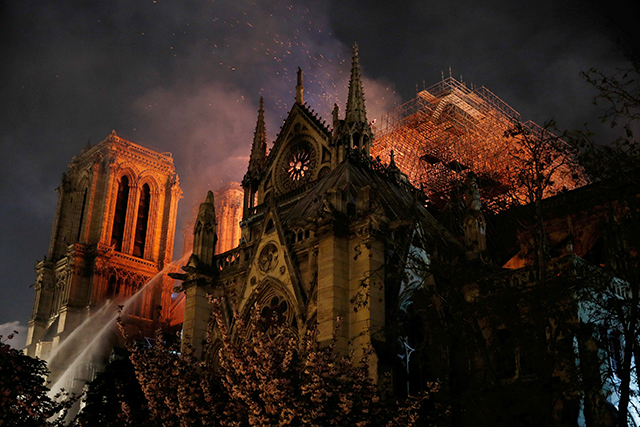The tragic April 15 fire at Notre Dame Cathedral in Paris underscored the value of preserving important monuments for future generations. The fire caused significant damage to the 427-by-157-foot structure — including the destruction of the spire and two-thirds of the wooden roof above the stone vaulted ceiling — as most of the world watched on in horror.
Notre Dame or “Our Lady of Paris” is a most special place, as we found out on a visit in the late 1990s. Construction began in 1160 and was completed a century later. They say that popular interest in the magnificent cathedral blossomed soon after the publication, in 1831, of Victor Hugo‘s novel “The Hunchback of Notre-Dame.”
Paris, as the third most popular city in the world to visit — New York City ranks eighth — boasts that Notre Dame itself generates 13 million visitors a year.
French President Emmanuel Macron has optimistically pledged that France will rebuild the fire-devastated cathedral, saying he expected the work would be done in five years. The French people must, he declared the day after the fire, pull together to repair their national symbol. One billion dollars has already been voluntarily pledged to the effort.
Are there any lessons to be learned for the state here?
Positivity is key
For one, it takes a Macron-like positive perspective to understand what makes a cold weather state like Minnesota so attractive to nearly 1 million foreign visitors a year. More broadly, including all visitors, there were some 75 million overnight and day trips in Minnesota last year, served by 270,000 full- and part-time workers in the industry.

[image_caption]Chuck Slocum[/image_caption]
According to State Tourism Director John Erdman of “Explore Minnesota,” expanded hotels, restaurants and events in cities and towns across the state have all contributed to increased visitation. In addition, the state is becoming more effective at bringing in major events like the NCAA Basketball Finals and Super Bowl LII. Natural and man-made attractions throughout the 848 square mile state enhance the visitor experience.
First Bank Stadium hosted sporting events are the single biggest draws, with a goal of 50 million visitors by 2030.
For every $1 in tourism investments, $101 in economic activity
The state organizes its tourism “markets” into five regions. The Twin Cities (arts and entertainment) is the most visited followed by Northeastern Minnesota (Lake Superior, Iron Range, and Duluth), Southern Minnesota (Rochester, Mankato), Central Minnesota (St. Cloud) and Northwestern Minnesota (Moorhead).
Certainly the state’s tourism investments have generated important revenue; for every $1 in promotion some $101 is generated from tourists for their food, lodging, transportation and retail purchases totaling hundreds of millions of dollars.
Tourists spend over $42 million a day, including some $1 billion in additional sales tax revenue alone every year. (If Minnesotans had to replace that kind of revenue, it would amount to an additional $625 annually for each taxpayer.)
Tourists say they favor all seasons, but some four in 10 prefer to come to Minnesota in June, July and August presumably to experience fresh water fun and fishing on some 15,000 or more lakes.
Looking forward to 2019 and beyond, a state-sponsored “Find Your True North” campaign, debuted by Gov. Tim Walz, is gaining some traction as part of the larger tourism movement — hopefully helping to inspire even more people to experience firsthand what Minnesota is all about.
In our state, not unlike France moving forward at this defining moment in its history, we must continue to plan our work and work our plan. Indeed, things seem to be moving the right direction in Minnesota as we welcome others to join us in experiencing the many wonders found in the place we call home.
Chuck Slocum is the president of The Williston Group, a management consulting firm; he can be reached at Chuck@WillistonGroup.Com.
WANT TO ADD YOUR VOICE?
If you’re interested in joining the discussion, add your voice to the Comment section below — or consider writing a letter or a longer-form Community Voices commentary. (For more information about Community Voices, see our Submission Guidelines.)






Hmmm…
Notre Dame Cathedral generates 13 million visitors per year.
The Mall of America 42 million.
Guess we need to insure the security and vitality of our sacred sites…
I think you might want to re-read the article. There were 13 million visitors to Notre Dame last year. 1 million foreign visitors visit Minnesota in a given year, not 42 million. The $42 million is the dollar amount spent by visitors on any given day in the State.
Explore Minnesota’s director’s name is John Edman, not Erdman.
Hmmm… $101 return on a $1 investment sounds like something every legislator would enthusiastically support. So why are the Senate Republicans slashing the budgets of the DNR and popular state parks and trails, trying to drastically curtail environmental standards that ensure our clean water and air, refuse to consider consistent transportation funding to allow us and our visitors to get around on decent roads and transit, and pass a devastating funding cut to the Minnesota Historical Society, which is one of our state’s cherished cultural amenities (a very petty retribution over a simple informational graphic at historic Ft. Snelling)? As the article points out, a lot of state funding and support is investment in our quality of life and is a primary factor in encouraging and facilitating the extremely important billion dollar tourism “industry”.